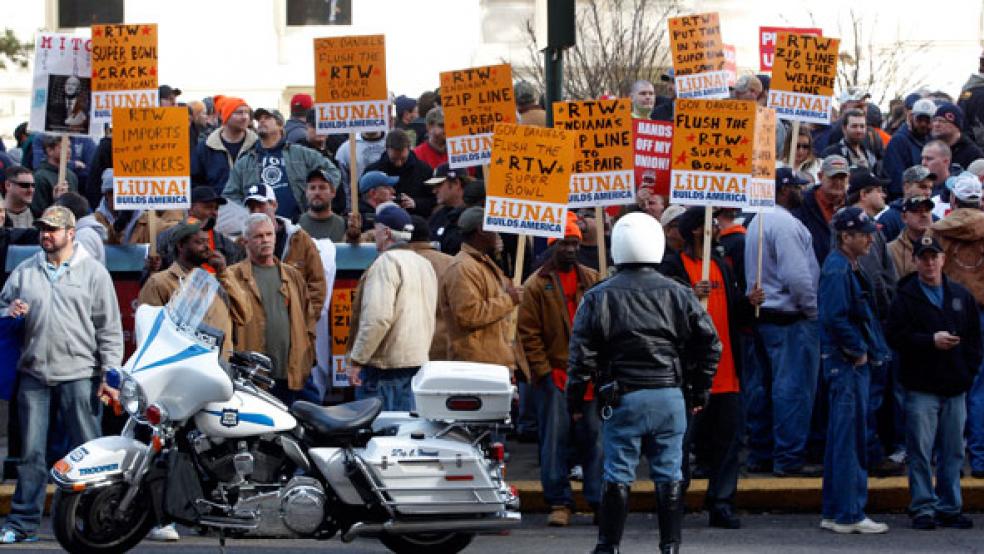Last week, Indiana became the 23rd state in the US to adopt right-to-work laws that prohibit closed shops and mandatory union-dues fees in workplaces. The change was notable for two reasons. First, it had been more than a decade since any state adopted right-to-work laws. But more importantly, Indiana is the first rust belt state – where manufacturing provided most of the economy and unions controlled large portions of the labor force – to pass such laws.
Few doubt that Indiana needs some changes to boost its economic development. At the time of the law’s passage, Indiana ranked 38th in employment with a 9 percent jobless rate. Their ranking for per capita income had fallen from 33rd in 2000 to 42nd in 2010, and their state rankings for 10-, 20-, and 30-year improvement in per-capita income range from 45th to 48th. Only Georgia, Nevada, and Michigan did worse on the 10-year measure.
RELATED: Bloated Union Contracts Have Busted State Budgets
Governor Mitch Daniels and the Republicans in the state legislature decided to address this by making the state regulatory climate more amenable to business, especially manufacturing, through the right-to-work effort. Indiana already passed union reform in its public sector a few years earlier, before Governor Scott Walker offered a slightly milder version of public-employee union reform and touched off a political firestorm in Wisconsin, another former manufacturing powerhouse.
In both cases, unions fought hard to maintain their grip on power. They tried to shut down the government in Wisconsin to block Walker’s PEU reforms, and then launched a series of recall efforts to retake control of the legislature and attempt to reverse the law.
They fell short after spending millions of dollars, and now will spend millions more attempting a recall of Walker himself. Walker now has a 51 percent approval rating, with Wisconsin voters evenly split on limiting collective-bargaining prerogatives of PEUs but overwhelmingly in favor of forcing public employees to pay more for their own pensions and benefits.
As with the Wisconsin reforms, unions and their allies predict doom and disaster for the state. At a rally just before the legislation passed, one union organizer claimed that the bill would “lower the state’s wages,” apparently to somewhere below Indiana’s current 42nd-place position. The organizer also said it would have “a devastating impact on the economy of Indiana,” as if being 48th out of 51 in terms of growth over the past ten years wasn’t bad enough.
Nor was the doom and gloom limited to Indiana. Democratic Minnesota governor Mark Dayton greeted the news that the state legislature would put a right-to-work constitutional amendment on the ballot in November by calling it an “extreme” position, and offered his economic analysis of right-to-work states.
“Look at the states that have right to work and compare their salary wage levels with states that don’t,” Dayton told the media. “The states that don’t have higher standards of living for their people. Better education systems. Better opportunity for people to at least negotiate for decent wages and retirement benefits and health care and the like.”
Put aside for the moment that Dayton mostly offered a non-sequitur, since people can negotiate for wages individually or collectively, and right-to-work laws don’t prevent either. They do prevent unions from forcing workers to pay dues as a job requirement whether those employees want to support a union or not. Are Dayton and union activists correct that right-to-work states have lower standards of living, experience slower growth, and economic stagnation?
Not according to the National Institute for Labor Relations Research, a non-profit that supports right-to-work legislation. Working from data provided by the federal Bureau of Economic Statistics, the NILRR looked at the ten years ending in 2010 to see whether right-to-work or “forced-unionism” states performed better economically.
Not only did RTW states show more job growth (RTW: 0.3 percent; forced unionism states: -5.5 percent; national average: 3.3 percent), real compensation grew by 11.3 percent. In states with closed shops, real compensation only grew 0.7 percent over those ten years while real compensation grew nationally at a 4.3 percent pace.
How did that impact the economic structure of these states? Manufacturing grew in forced-unionism states by 8.3 percent during that decade – but it grew by 18.6 percent in right-to-work states. As far as standards of living, the data disputes Dayton and other opponents of right-to-work laws. By 2010, income adjusted for the cost of living by the BEA was slightly higher in right-to-work states, as was cost-of-living adjusted real disposable income.
Nor was the NIRLL the only one to check those figures. Dr. Mark Perry, professor of economics and finance at the University of Michigan, checked the BEA’s figures and reported his findings on his personal blog, Carpe Diem. Perry confirmed the NIRLL’s findings on private-sector compensation growth, and found a few more nuggets as well. Private sector employment grew by 10 percent in the same decade in RTW states, while the rate in forced-unionism states was only 1.9 percent.
Perry also specifically looked at the 2000-7 period for employment and found this stunning result: “In the period between 2000 and 2007 -- before the recession started -- almost 8 million jobs were created in right-to-work states compared to fewer than 6 million new jobs in forced union states, even though forced union states outnumber right-to-work states 28 to 22 and have populations and labor forces that are 65 percent greater than right-to-work states.”
Clearly, right-to-work states outperformed their counterparts across a wide range of economic measures. Why, then, are Democrats like Governor Dayton so opposed to right-to-work laws? Survival. Democrats rely heavily on union support, both in organization and fundraising. Both depend on the collection of dues from millions of members locked in closed shops, who have their paychecks picked by their employers no matter what they think of their union. Since Democrats in Indiana get a third of their donations from these forced contributions to unions, the rights of workers and the economic vitality of their states take a back seat to keeping their own coffers filled.
Mark Mix, president of the National Right to Work Committee, told the Christian Science Monitor that unions are running scared. “"The reason union officials are scared of right to work,” Mix said, “is they're worried that if workers in Indiana have a choice to support them, some will choose not to.” Sounds as if Democrats are worried about the same thing, and not just in Indiana. They need to stop this Rust Belt revolution before it threatens their standing in every state.





